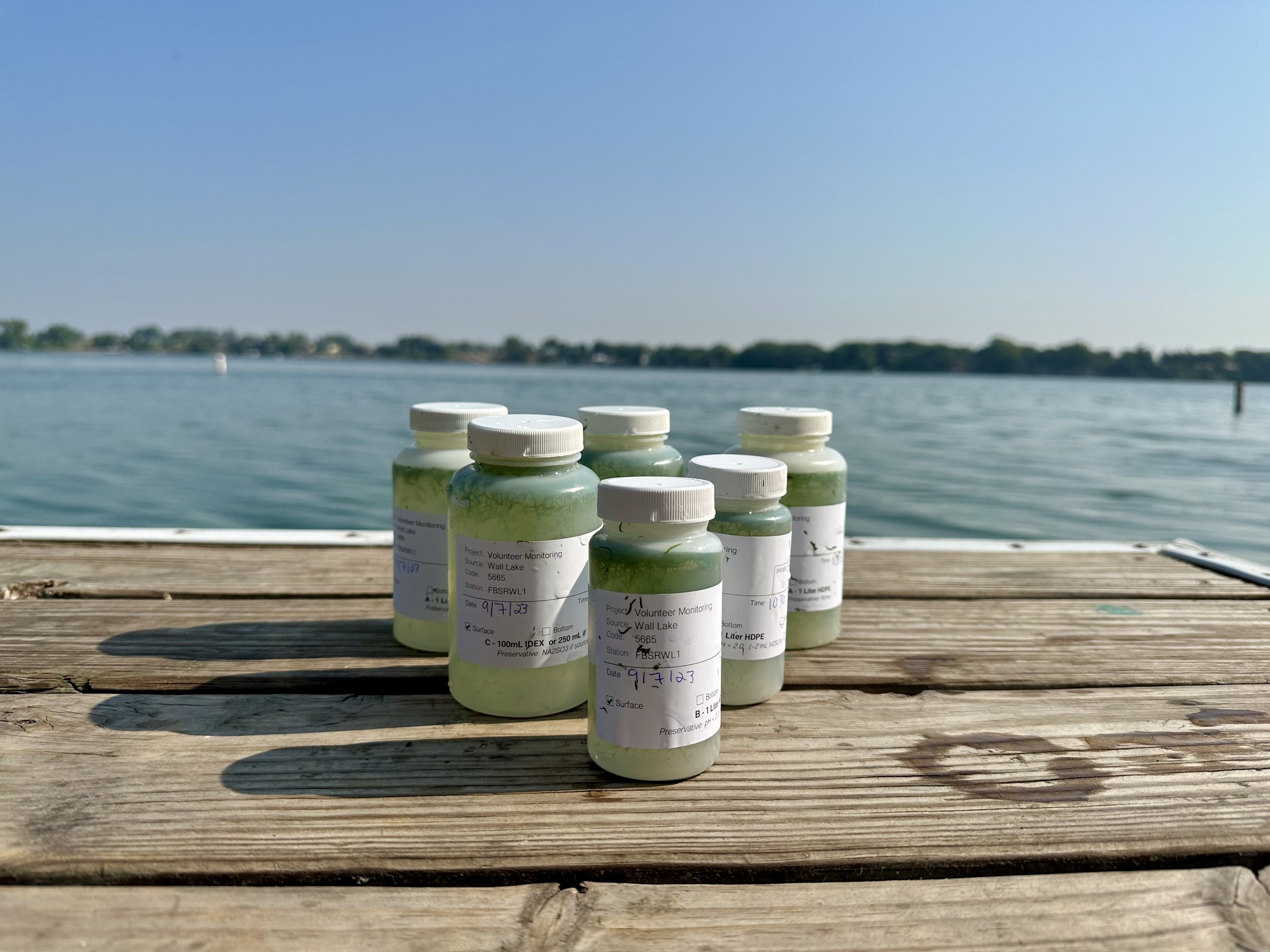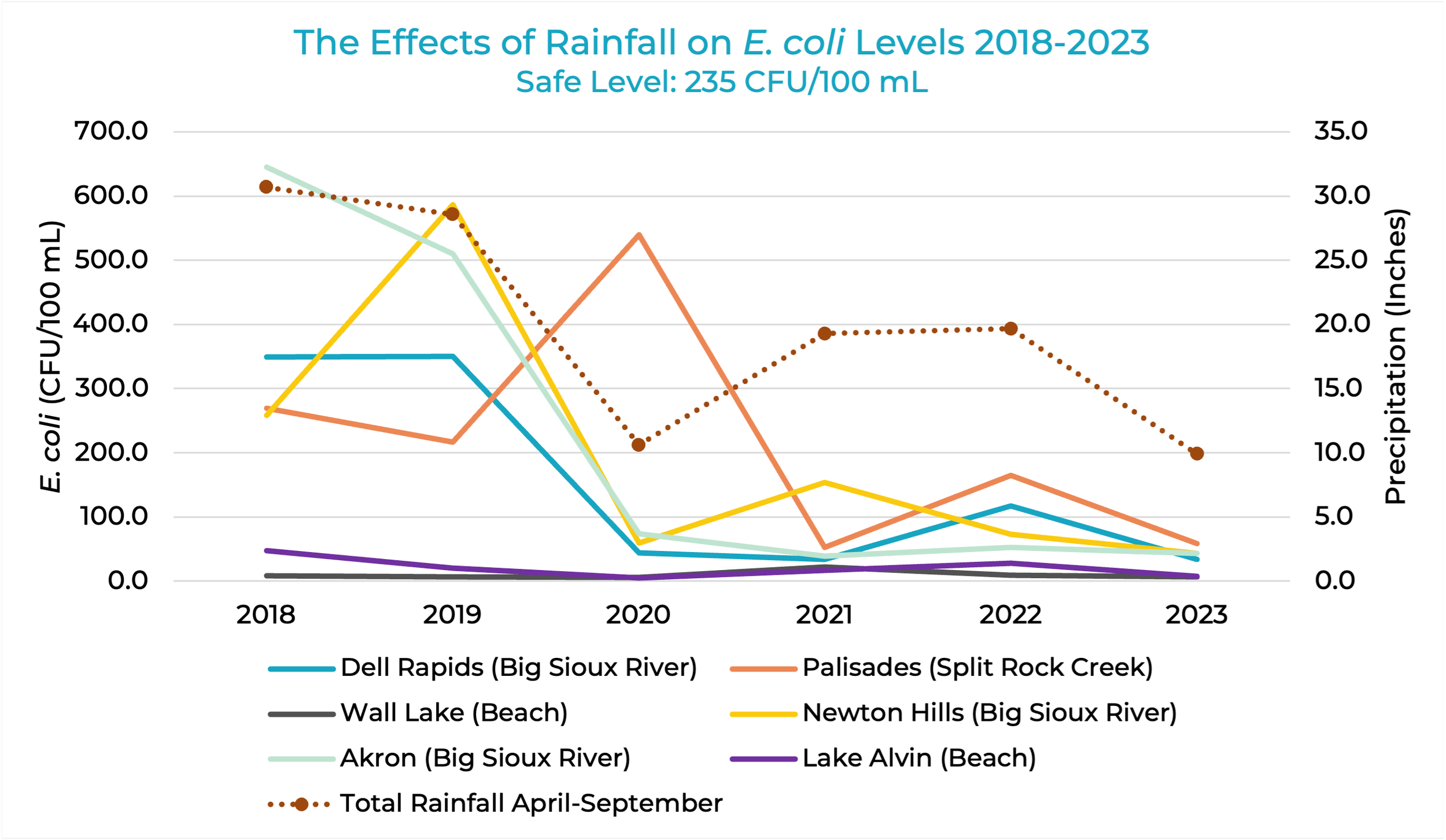
Water Quality
Recent water crises across the US have elevated awareness regarding the importance of water and rivers for communities. By being proactive, we can avoid the struggles and costs associated with the maltreatment of an important resource. At Friends of the Big Sioux River, we are concerned about the public health ramifications of our water. Between May and September every year, we conduct weekly water testing throughout the watershed. We test for three primary contaminants that impair water quality: 1) total suspended solids from soil erosion, 2) E. coli from animal waste, and 3) nitrates from fertilizer. The test results are used by the South Dakota Department of Agriculture and Natural Resources and posted weekly on our website. When contaminant levels are high and immersion is unsafe, we believe that warning the public is the proper thing to do. To learn more about water quality and view our testing results, scroll down or click the buttons below.
Water Quality is Important For:
Growth & Development
People are attracted to a community for its quality of life, which includes clean water, scenery, and recreation.
Recreation & Tourism
A clean river attracts tourists and residents who want to fish, kayak, and swim. According to a 2012 study by the Outdoor Industry Association, outdoor recreationists spent $120.7 billion on equipment and $524.8 billion on services, generating a $1.6 trillion economic impact and 12 million jobs. A healthy river equals a healthy economy.
Safe Local Water
Protecting local water allows communities to source water locally, which is cheaper and simpler than piping it in from long distances. Cleaner water is cheaper water. In treating water for the city of Des Moines, the Des Moines Water Works spent $7,000 a day removing excess nitrates, a cost that is ultimately passed on to the consumers.
Health of People & Wildlife
Every living creature needs clean water for healthy development. Unclean water can be hazardous, even deadly.
State of Our River
2022 DANR Integrated Report for Surface Water Quality Assessment Data
The following information and map are gathered and developed from the 2022 South Dakota Integrated Report for Surface Water Quality Assessment prepared by the South Dakota Department of Agriculture and Natural Resources. Data in the report were collected between October 2016 & September 2021.
Total Suspended Solids (TSS)
75% Impaired
75% of Big Sioux River segments are impaired for TSS. Only 25% meet the beneficial use standard of warm water semipermanent fish life propagation (158 mg/l).
E. Coli
69% Impaired
69% of Big Sioux River segments are impaired for E. coli. Only 31% meet the beneficial use standard of limited contact recreation (1,178 CFU/100 ml) and/or immersion recreation (235 CFU/100 ml).
Nitrates
0% Impaired
100% of Big Sioux River segments meet the beneficial use standard for nitrates of domestic water supply 10 mg/L.
2004-2022 Big Sioux River Impairment Status
Every two years, SD DANR produces an Integrated Report for Surface Water Quality Assessment for all waterbodies in the state. The Big Sioux River is split into 16 segments, each with a list of beneficial uses. A waterbody is considered impaired when it does not meet its beneficial use criteria. The graph to the right indicates the percent of impaired river segments for three contaminants in the Big Sioux River from 2004 through 2022. E.coli was not added to the report until 2010. TSS and E.coli spiked in the mid-2010s but have been on the decline since 2018. Nitrate impairment has been at 0% since 2010. Overall, these data show an improvement in water quality in the Big Sioux River over the last five years.
2004-2022 Big Sioux River E. coli Beneficial Use Status
SD DANR lists E. coli as having two beneficial uses: Limited Contact Recreation and Immersion Recreation. Of the 16 segments of the Big Sioux River, nine are designated for Immersion Recreation (235 CFU/l00mL) and 16 for Limited Contact Recreation (1,178 CFU/100 ml). Due to the disease risk posed by E. coli, we believe it is important to inform the public of the river's E. coli impairment status. Since 2012, all nine Immersion Recreation segments have been considered impaired or unsafe for swimming. Limited Contact Recreation impairment peaked in 2016, but it has been steadily declining ever since. These data indicate that E. coli levels in the river are improving year over year.
2023 Key Trends
In 2022, Sioux Falls received 17.47 inches of rain between May and September. In 2023, the watershed experienced a significant decrease in rainfall, with only 9.03 inches of rain falling in the city in the same period. As a result, we saw an improvement in water quality.
E. coli
On average, in 2023, E. coli levels exceeded the designated use criteria of 235 CFU/100 mL at two of the 17 sampled sites, including the popular recreation spot of Palisades State Park. Ten sites exceeded the designated use criteria at least once during the 2023 testing season.
Nitrates
On average, in 2023, nitrate levels did not exceed the designated use criteria of 10 mg/L. One of the sites exceeded the designated use criteria at least once during the 2023 testing season.
Total Suspended Solids (TSS)
On average, in 2023, TSS levels did not exceed the designated use criteria of 158 mg/L at the 17 sampled sites. Two sites exceeded the designated use criteria at least once during the 2023 testing season.
FBSR Annual Water Testing Results
What am I looking at?
Friends of the Big Sioux River recognizes three primary contaminants that impair water quality: 1) total suspended solids (TSS) from soil erosion, 2) E. coli from animal waste, and 3) nitrates from fertilizer. During the summer months, we test for these three contaminants to determine if bodies of water are meeting the criteria for their designated uses (DUs). The safe levels have been assigned by the South Dakota DANR.
Testing Parameters
Nitrates: 10 mg/L
E. coli: 235 CFU/100mL
Total Suspended Solids (TSS): 158 mg/L
The South Dakota Department of Agriculture and Natural Resources designates all surface waters in South Dakota for one or more of 11 beneficial uses, also called designated uses. At Friends of the Big Sioux River, we recognize and use these criteria to indicate safe contaminant levels for our local waterbodies. We use the strictest beneficial use standards, as we firmly believe that our local waterbodies should be as clean and healthy as possible. The beneficial use criteria used by FBSR are as follows:
Daily maximum nitrate levels must be 10 mg/L or lower to meet the beneficial use of domestic water supply, e.g., drinking water.
Daily maximum E. coli levels must be 235 CFU/100 mL or lower to meet the beneficial use of immersion recreation. The geometric mean, which is a type of average of all the test results obtained during a reporting period, must be 126 CFU/100 mL or lower to meet the beneficial use of immersion recreation.
Daily maximum total suspended solids (TSS) must be 158 mg/L or lower to meet the beneficial use of fish life propagation for multiple fish species. The 30-day average must be 90 mg/L or lower to meet the beneficial use of fish life propagation for multiple fish species.
Why These Sites?
The sites selected by FBSR are common points of recreation and often have DUs of swimming and limited contact recreation. If test results reveal contaminant levels that exceed established safe levels, they are not safe for their DUs, including swimming and limited contact recreation. We are providing you with this water quality data so you can make safe, informed decisions about your summer recreation.
Six-Year Trends
For the past six years, Friends of the Big Sioux River has collected water samples in the Big Sioux River watershed. While some sites have changed over the years, six of our sample sites have remained the same. The following graphs plot the average contaminant levels at the six sites sampled by FBSR between 2018 and 2023 against the total rainfall between April and September of each year. These data can be used to help determine how rainfall affects average contaminant levels and, subsequently, water quality. A geometric mean was used to calculate the averages instead of arithmetic mean.
E. coli
E.coli levels are elevated in years with higher total rainfall. In periods of drought, E.coli levels generally decrease. However, Palisades saw a significant increase in 2020. Overall, these data signify a direct correlation between precipitation and E. coli levels.
The presence of fecal coliform bacteria in aquatic environments indicates that the water has been contaminated with the fecal material of people or other animals.
Common sources of E. coli include agriculture runoff, wastewater treatment plants, failing septic systems, domestic and wild animal waste, and stormwater runoff.
Total Suspended Solids (TSS)
TSS levels are elevated in years with higher total rainfall. In periods of drought, TSS levels decrease. These data signify a direct correlation between precipitation and TSS levels.
TSS can include a wide variety of materials, such as silt, decaying plant and animal matter, industrial wastes, and sewage.
High TSS levels decrease water clarity and can interfere with water chemistry and photosynthesis processes.
Nitrates
Nitrate levels are elevated in years with higher total rainfall. In periods of drought, nitrate levels decrease. These data signify a direct correlation between precipitation and nitrate levels.
Nitrates are an essential source of nitrogen for plants and are commonly used in fertilizers.
When nitrogen fertilizers are used to enhance soil fertility, nitrates may be carried by rain over or through the soil and deposited in surface water.
High levels of nitrates in drinking water can lead to Blue Baby Syndrome and an increased risk of certain cancers and thyroid dysfunction.
Past Testing Results
Curious about past water quality testing data? Click on the links below to view the results.
2022 Summary | 2022 Report Card
2021 Summary | 2021 Report Card
2020 Summary
2019 Results
Project sponsored in part by the Sioux Falls Area Community Foundation.










